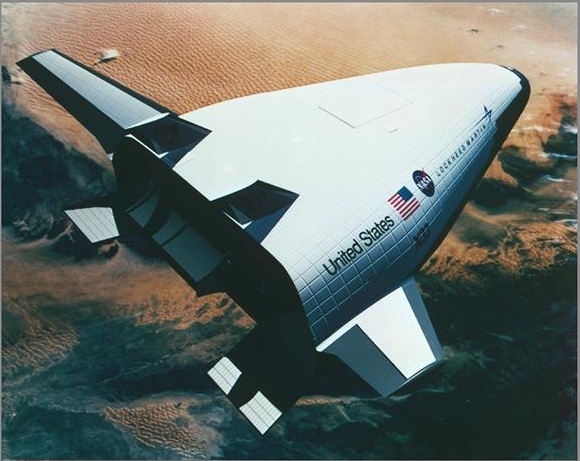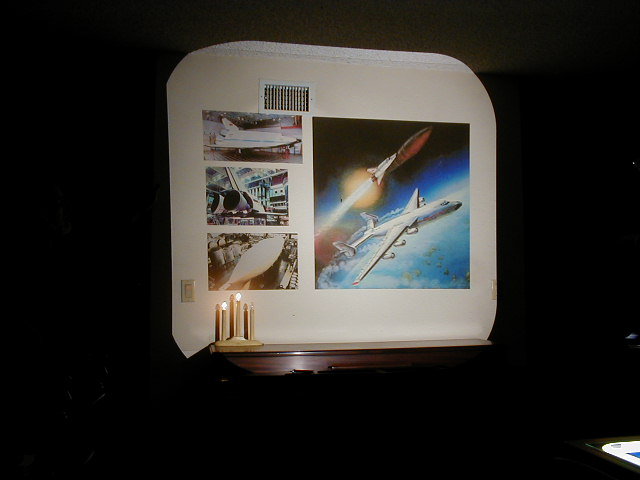






Editor: Kris Cerone
RLVs Are HARD To Do!
Says OASIS Speaker
Continued from November
By Steve Bartlett
In his talk, James discussed the history of RLV efforts, beginning with the German work during World War II. The Von Braun team built a half-scale prototype of the V2 rocket, designated the A5 that was used to collect supersonic aerodynamics data. The A5 was launched from the test site at Peenemunde and carried a parachute that allowed it to land in the Baltic Sea, where waiting ships recovered it.
The Germans developed other reusable rocket concepts during the war for attacking Allied targets, including an "antipodal bomber" designed to launch from Germany, fly over the Atlantic Ocean, skip off the atmosphere, and drop bombs on the cities of the U.S. East Coast. This rocket would be recovered in the western Pacific Ocean, refurbished, and launched back across the Pacific to bomb targets on the U.S. West Coast. The European Space Agency and German Space Agency later resurrected the project in the 1980's as the air breathing Sanger II concept for putting payloads into orbit.
 |
| Artists concept for the Venturestar space vehicle. NASA/Lockheed-Martin |
Von Braun's next concept, put forth in the 1950's, featured three stages. The first two stages included parachutes for recovery, while the third had wings, aerodynamic control surfaces, reaction control rockets, and a heat shield.
In the late 1960's Max Hunter's team at Lockheed, Sunnyvale, put forth the Star Clipper concept. This featured a disposable set of propellant tanks, which are the least expensive part of the rocket, and recoverable engines, crew cabins, and avionics. Lockheed offered to develop the Star Clipper using its own funds if NASA would guarantee that it would buy a set number of flights per year of the rocket. The agency decided not to do so because they felt that the 30,000-pound payload of the vehicle was too small for their needs.
James commented that the Space Shuttle development effort of the 1970's was a technological and economic dead end. For the Shuttle to be a fully reusable, two stage-to-orbit vehicle, it would have required two large "spikes" in funding to cover the development of each stage. The government chose to eliminate the development costs for one of the stages by employing a large, expendable external propellant tank and two semi-recoverable solid rocket boosters. As a result, the true reusability of the system was compromised. The Shuttle became substantially more complicated and more difficult to service and maintain than originally envisioned.
The Delta Clipper concept of the late 1980's and early 1990's adopted the conical shape of a re-entry vehicle. It took off and landed vertically. Like many of the RLV approaches, it had aerodynamic stability issues because it was "tail heavy" with its engines at the rear of the rocket when it returned to Earth. In addition, the engines had to work on landing or the rocket would be destroyed by a crash into the ground. (General Dynamics developed one concept that James favored. It avoided the aerodynamic stability problem by featuring a tail-first re-entry from orbit.)
 |
| Warren James showing a Russian vechicle concept. Photo courtesy Steve Bartlett. |
In the late 1990's, NASA and Lockheed-Martin worked to develop the X-33/Venturestar RLV concept. The rocket featured a lifting body shape and linear aerospike engines. This approach suffered from substantial stability and controllability problems, as well as tank development and packaging issues. The design gradually evolved from wind tunnel testing to include large canted fins to improve stability. The program was cancelled after the government and Lockheed-Martin spent nearly $1 billion developing it. The orbital version of the Venturestar would have been the size of four Shuttle External Tanks and featured an external payload bay.
Other concepts that James discussed included the NASA HL10, derived from the Russian La Potocketplane; the Pioneer Pathfinder rocket, featuring aerial refueling to reduce the size of the rocket; and the air-launched MAKS rocket, designed by the Soviet Union in the late 1980's and featuring a modest-sized expendable propellant tank. The speaker prefers the MAKS approach to many of the others for near-term development because of its reasonable simplicity and lower development cost. He pointed out that the Soviets built two of the large AN225 aircraft to launch the MAKS rocket, as well as full-scale mockups of the rocket itself.
He concluded his talk by saying that there has yet to be built a workable reusable launch vehicle, in part because they are very large, very complex, and are very expensive to develop. James mentioned that the time for a commercial company to recover the development costs of an RLV are on the order of twenty-five years.
Warren James has worked on numerous aerospace programs in his career, including the Galileo mission to Jupiter, the Magellan probe to Venus, the Alpha space station, and the Delta Clipper and Venturestar RLV projects. He is currently involved with the Space Launch Initiative RLV program. He served as the host of the Sci-Fi Trader program on television's Sci-Fi channel and hosts the web-based Hour25 science fact and science fiction audio program. (URL: http://www.hour25online.com.)
Copyright © 1998-2003 Organization for the Advancement of Space Industrialization and Settlement. All Rights Reserved.